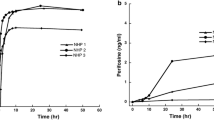Abstract
Imatinib, an orally administered tyrosine kinase inhibitor of PDGF receptor, c-abl and c-kit, is currently in clinical trials to assess its efficacy in malignant gliomas. Although imatinib does not readily penetrate an intact blood–brain barrier (BBB), the extent to which it distributes into regions of high grade gliomas where the BBB is compromised has not been determined. Patients with recurrent high-grade gliomas for whom repeat surgical tumor debulking was clinically indicated received imatinib mesylate 600 mg orally once a day for seven days prior to surgery. Tissue samples were collected from different regions of the tumor and the approximate location of these samples was determined using frameless stereotactic neuronavigation. Plasma samples were obtained immediately before and after the resection. The concentration of imatinib in the plasma and tumor samples was determined using high performance liquid chromatography with mass spectrometric detection. Eleven tumor samples were obtained from three patients with recurrent glioblastoma multiforme. The median concentration of imatinib in these 11 tumor specimens was 1.34 μg/g (range 0.21–4.31 μg/g) and the median tumor-to-plasma ratio was 0.71 (range 0.28–3.03). These findings suggest that imatinib can reach intratumoral concentrations similar to those or higher than in plasma in regions of glioblastoma where the BBB is disrupted as indicated by contrast enhancement on magnetic resonance imaging.

Similar content being viewed by others
References
Kilic T, Alberta JA, Zdunek PR et al (2000) Intracranial inhibition of platelet-derived growth factor-mediated glioblastoma cell growth by an orally active kinase inhibitor of the 2-phenylaminopyrimidine class. Cancer Res 60(18):5143–5150
Reardon DA, Egorin MJ, Quinn JA et al (2005) Phase II study of imatinib mesylate plus hydroxyurea in adults with recurrent glioblastoma multiforme. J Clin Oncol 23(36):9359–9368
Desjardins A, Quinn JA, Vredenburgh JJ et al (2007) Phase II study of imatinib mesylate and hydroxyurea for recurrent grade III malignant gliomas. J Neurooncol 83(1):53–60
Wen PY, Yung WK, Lamborn KR et al (2006) Phase I/II study of imatinib mesylate for recurrent malignant gliomas: North American Brain Tumor Consortium Study 99–08. Clin Cancer Res 12(16):4899–4907
Raymond E, Brandes AA, Dittrich C et al (2008) Phase II study of imatinib in patients with recurrent gliomas of varying histologies: a European Organization for Research and Treatment of Cancer Brain Tumor Group Study. J Clin Oncol 26(28):4659–4665
Leis JF, Stepan DE, Curtin PT et al (2004) Central nervous system failure in patients with chronic myelogenous leukemia lymphoid blast crisis and Philadelphia chromosome positive acute lymphoblastic leukemia treated with imatinib (STI-571). Leuk Lymphoma 45(4):695–698
le Coutre P, Kreuzer KA, Pursche S et al (2004) Pharmacokinetics and cellular uptake of imatinib and its main metabolite CGP74588. Cancer Chemother Pharmacol 53(4):313–323
Neville K, Parise RA, Thompson P (2004) Plasma and cerebrospinal fluid pharmacokinetics of imatinib after administration to nonhuman primates. Clin Cancer Res 10(7):2525–2529
Parise RA, Ramanathan RK, Zamboni WC, Egorin MJ (2003) Sensitive liquid chromatography-mass spectrometry assay for quantitation of docetaxel and paclitaxel in human plasma. J Chromatogr B Analyt Technol Biomed Life Sci 783(1):231–236
Akingbemi BT, Braden TD, Kemppainen BW et al (2007) Exposure to phytoestrogens in the perinatal period affects androgen secretion by testicular Leydig cells in the adult rat. Endocrinology 148(9):4475–4488
Dresemann G (2005) Imatinib and hydroxyurea in pretreated progressive glioblastoma multiforme: a patient series. Ann Oncol 16(10):1702–1708
Bihorel S, Camenisch G, Gross G, Lemaire M, Scherrmann JM (2006) Influence of hydroxyurea on imatinib mesylate (Gleevec) transport at the mouse blood-brain barrier. Drug Metab Dispos 34(12):1945–1949
Bihorel S, Camenisch G, Lemaire M, Scherrmann JM (2007) Influence of breast cancer resistance protein (Abcg2) and p-glycoprotein (Abcb1a) on the transport of imatinib mesylate (Gleevec) across the mouse blood-brain barrier. J Neurochem 102(6):1749–1757
Dai H, Marbach P, Lemaire M, Hayes M, Elmquist WF (2003) Distribution of STI-571 to the brain is limited by P-glycoprotein-mediated efflux. J Pharmacol Exp Ther 304(3):1085–1092
Razis E, Selviaridis P, Fletcher J et al (2007) Biochemical evidence of tumor response and measurable levels of the drug in glioblastoma tissue from patients treated with imatinib. J Clin Oncol 25(18S):2023 (Abstract)
Kuhn J, Robins HI, Mehta M et al (2008) Tumor sequestration of lapatinib (NABTC 04–01). Neuro Oncol 10(5):783 (Abstract)
Lassman AB, Rossi MR, Raizer JJ et al (2005) Molecular study of malignant gliomas treated with epidermal growth factor receptor inhibitors: tissue analysis from North American Brain Tumor Consortium Trials 01–03 and 00–01. Clin Cancer Res 11(21):7841–7850
Kuhn JG, Chang SM, Wen PY et al (2007) Pharmacokinetic and tumor distribution characteristics of temsirolimus in patients with recurrent malignant glioma. Clin Cancer Res 13(24):7401–7406
Cloughesy TF, Yoshimoto K, Nghiemphu P et al (2008) Antitumor activity of rapamycin in a phase I trial for patients with recurrent PTEN-deficient glioblastoma. PLoS Med 5(1):e8
Acknowledgements
Thanks to Joy Fisher for her advice during protocol development and during the institutional review process. We thank Dr. Jaishri Blakeley, Dr. Jon Weingart and Dr. Alfredo Quinones-Hinojosa for referral of patients for this study. Thanks also to Kelly Szajna and Kimberly Boucher for their help in patient recruitment and data management. Novartis Pharmaceuticals kindly provided the imatinib mesylate samples that were used in this study.
Author information
Authors and Affiliations
Corresponding author
Rights and permissions
About this article
Cite this article
Holdhoff, M., Supko, J.G., Gallia, G.L. et al. Intratumoral concentrations of imatinib after oral administration in patients with glioblastoma multiforme. J Neurooncol 97, 241–245 (2010). https://doi.org/10.1007/s11060-009-0008-0
Received:
Accepted:
Published:
Issue Date:
DOI: https://doi.org/10.1007/s11060-009-0008-0




